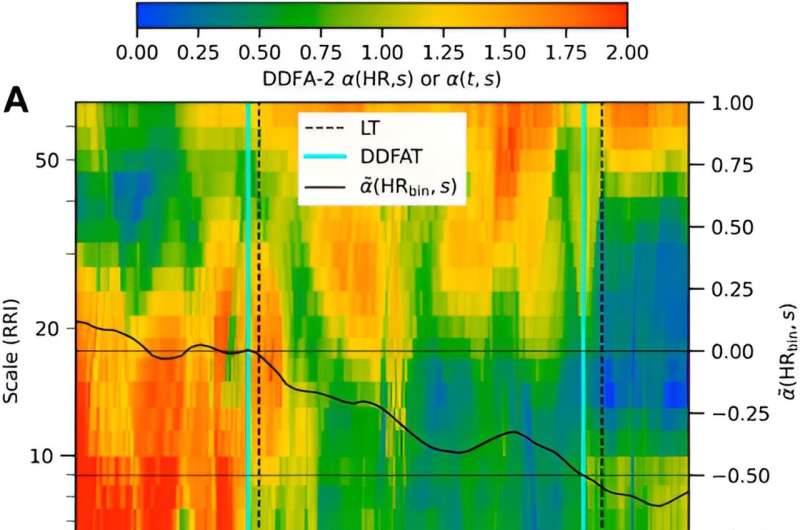This article has been reviewed according to Science X's editorial process and policies. Editors have highlighted the following attributes while ensuring the content's credibility:
fact-checked
peer-reviewed publication
trusted source
proofread
A new method based on computational time series analysis allows the estimation of exercise thresholds

The monitoring of an athlete's exertion during performance is often done through personal heart rate zones. Heart rate zones can be categorized based on the heart rate of basic, tempo, and maximum endurance zones, which are separated by aerobic and anaerobic thresholds.
For endurance athletes, knowing these heart rate zones and personal thresholds are crucial for optimizing training. Continuous training at too high intensity can potentially lead the overload of the body and significantly increase the risk of injuries.
An athlete's aerobic and anaerobic thresholds are determined by analyzing blood lactate levels and respiratory gas composition in a laboratory during exercise. However, these measurements are cumbersome and expensive. The maximum heart rate has also been used to determine thresholds, but it does not yield reliable results.
Estimating the maximum heart rate is not precise, and there is significant individual variability in heart rate zones. For instance, the anaerobic threshold might be 80% of the maximum heart rate for a recreational athlete but as high as 95% for an elite athlete. Current algorithms in sports watches do not account for this variability.
Solutions from the behavior of heartbeat intervals
Led by Professor Esa Räsänen, a research group in computational physics at Tampere University has been developing novel time-series analysis methods for years. These methods have been utilized in computational cardiology, notably in identifying various heart diseases.
The techniques study characteristics of the complex time series formed by heart rate variability, such as interdependencies between heartbeat intervals and their changes in various situations like illnesses, medications, physical activity, or sleep.
During physical activity, the interdependencies of heartbeat intervals systematically change. With this knowledge, the physiological thresholds can be predicted.
"This new method utilizes heartbeat interval measurements from sports watches and heart rate monitors that are already familiar to consumers. Therefore, the analytics can be easily integrated into various smart devices and sports applications provided by device manufacturers. This allows the optimization of training. Also, elite athletes, coaches, and sports clubs would benefit from continuous performance monitoring," says doctoral researcher Matias Kanniainen.
The method has been successfully tested in collaboration with Kauppi Sports Coaching Ltd, utilizing results from cycle ergometer tests. Further research with extensive data is currently underway in collaboration with the Faculty of Sport and Health Sciences of the University of Jyväskylä and the Finnish Institute of High Performance, KIHU.
Additionally, a letter of intent for collaboration with Suunto Oy has been made to implement the methods in consumer devices.
Research results were first recognized in September at the Finnish Congress on Sports Sciences 2023, organized by the Finnish Society of Sports Sciences in Jyväskylä.
The study was published in Frontiers in Physiology.
More information: Matias Kanniainen et al, Estimation of physiological exercise thresholds based on dynamical correlation properties of heart rate variability, Frontiers in Physiology (2023). DOI: 10.3389/fphys.2023.1299104




















